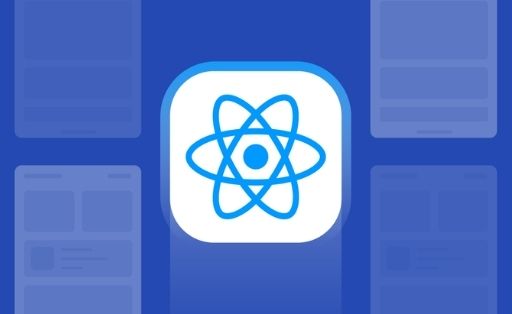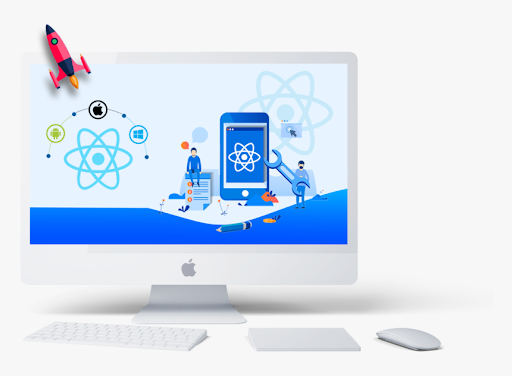The React Native framework is used to develop cross-platform Android and iOS applications. It seriously competes with Flutter – both platforms occupy a significant share of the mobile development market. React Native development is actively supported by Facebook companies and has a large community of developers all over the world. Due to such powerful support emerging issues are solved most accurately and quickly, every year the technology gains momentum and acquires more and more possibilities.
React Native Apps is based on ReactJS, but it doesn’t use WebView, so there’s no DOM API. There’s also no HTML and CSS, but it does have some platform components in JSX and CSS-like polyfills. React Native contains some JavaScript API over native components. This means that native components have a link (bindings) to JavaScript components on ReactJS. The native and JavaScript bundle communicate through a bridge using the JavaScript API. If you take it superficially, that’s the entire architecture of the technology.

Contents
What applications React Native is used for
The React Native library is universal and the tools can be used in different projects:
- Social networks. The experience of large social networks demonstrates the benefits of using React Native to develop multiple elements – commenting functionality, forming news feeds, launching video broadcasts, publishing textual content, user authentication, etc.
- Entertainment services. React Native has been successfully used to embed elements of social networks in mobile applications – comments, subscriptions, ratings, likes, etc.
- Messengers. The React Native library is used to create interfaces for messengers and to implement additional functionality specific to these kinds of applications.
- Dashboards. React Native is used in app development for real-time data collection, analysis, and visualization.
- E-commerce systems. React Native is used to create advanced functionality for online stores, marketplaces, and other commercial applications with an online purchasing option.
- Task Schedulers. Library components are used in creating applications to manage tasks, projects, time, and teamwork.
- CRM systems. React Native allows you to create applications of complex CRM systems – application software, customized to the needs of a particular organization to automate business processes.
The scope of React application is not limited by this list. With a professional approach, the programmer can solve problems of varying complexity and adapt the capabilities of the library for any project.

Benefits of React Native
React Native allows you to release complete native React components. In the past, when React didn’t yet exist, developers wrote mobile apps in HTML5. Such apps ran in an embedded WebView mini-browser, which was enclosed in a shell. This approach worked, but it had a lot of disadvantages: low speed, lack of ability to use internal resources of the device, high memory consumption, and other problems that severely limited the applications.
The advantages of React Native for the developer:
- Modularity, using a set of ready-made components. The developer operates with ready-made components, each of which solves specific problems – this speeds up and simplifies the design process.
- Version compatibility. The library is constantly evolving, updates are released, the product is improved. New versions are fully compatible with previous ones.
- Repeatability of components. You get a shorter design time by reusing components in different sections of your project.
- Efficient error control. With child components included in the parent components, you get a simple and clear architecture that makes it easier to find and fix bugs.
- Reducing the load on the server when the application is running. The page opens faster, the interface becomes more responsive to user actions.
React Native develops cross-platform applications that can function equally on multiple platforms. They work as Native Apps – fully native applications that take into account the features of iOS and Android systems. This approach allows reducing the project realization period, budget, and support costs after the launch. And all this with a high level of quality, reliability, and functionality of the application.
Benefits of React Native for the client:
- Savings. Using React Native components simplifies the process and reduces design time, due to which the development cost is reduced. For the customer, this is an opportunity to get a reliable and productive application and save money at the same time. This is the case when the lower price of a mobile app is in no way reflected in the quality of the product.
- Affordable support. React Native is a progressive direction that will grow and develop in the future. The customer will not have any problems with support, any modifications and improvements will be implemented as quickly and easily as possible.
- User-friendliness. Instant response to user actions, pleasant control of options, good dynamics of the interface – all these benefits are highly appreciated by the target audience, which is positively reflected in the conversion rates.
- Faster time to market. Fast and relatively inexpensive development will launch the project in the shortest possible time, ahead of competitors.
- Minimal risks. React Native is beneficial for customers who are just testing the waters and do not know the needs of the target audience. The tool allows it to launch in the shortest time possible, and after the launch – to make changes to the project at any stage, adjust the interface depending on the actual behavioral factors, thereby reducing possible risks to the business.
How application development works
After a client has voiced his or her business idea to the development team, marketing research begins. This stage helps to identify trending features, technologies, and development approaches. Based on the collected data, the developers begin to compile a list of specifications (formal requirements – technical and non-technical – for the product), agree on it with the client, and finally start the development process.
In particular, first, designers build a template taking into account the business logic (logical transitions, drop-down windows, etc.), which can already be demonstrated to the client. Next, the development team proceeds to create a backend and frontend. Along with this, the previously created prototype of the interface is detailed and gradually brought to the final one. As each of the subtasks is completed, the work done is tested and, if necessary, sent back to the developers to fix bugs (non-compliance with specifications). Note that the development of mobile software on React Native in its stage-by-stage is no different from the development on other popular cross-platform frameworks, and is perfect for implementing an agile methodology.
Conclusion
As you can see, React Native, being a product from the “stellar” Facebook team, continues to be one of the top solutions for mobile development, which is regularly confirmed by world-famous companies that choose it for their projects. Indeed, given such advantages as reliability, code reusability, extensive compatibility with third-party solutions, high performance in comparison with other products, constant development, and, of course, the ability to build cross-platform applications, this product can be considered one of the best that exists on the mobile development market today.
